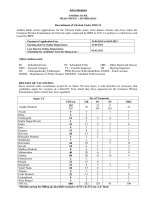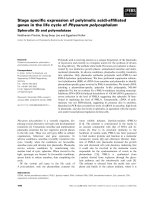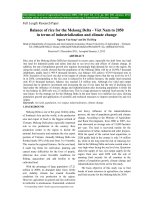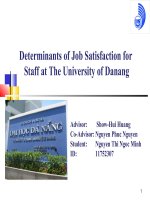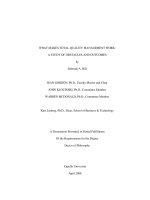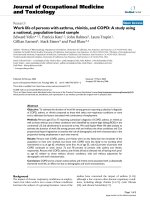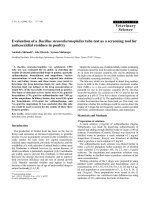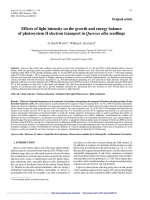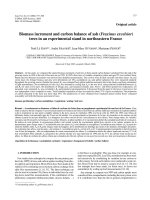Work life balance of agribank head office staff
Bạn đang xem bản rút gọn của tài liệu. Xem và tải ngay bản đầy đủ của tài liệu tại đây (853.87 KB, 72 trang )
ĐẠI HỌC QUỐC GIA HÀ NỘI
KHOA QUẢN TRỊ VÀ KINH DOANH
---------------------
PHÙNG NGUYỄN MINH TÂM
CÂN BẰNG CÔNG VIỆC – CUỘC SỐNG
CỦA NHÂN VIÊN TRỤ SỞ CHÍNH AGRIBANK
WORK-LIFE BALANCE
OF AGRIBANK HEAD OFFICE STAFF
LUẬN VĂN THẠC SĨ QUẢN TRỊ KINH DOANH
HÀ NỘI - 2020
ĐẠI HỌC QUỐC GIA HÀ NỘI
KHOA QUẢN TRỊ VÀ KINH DOANH
---------------------
PHÙNG NGUYỄN MINH TÂM
CÂN BẰNG CÔNG VIỆC – CUỘC SỐNG
CỦA NHÂN VIÊN TRỤ SỞ CHÍNH AGRIBANK
WORK-LIFE BALANCE
OF AGRIBANK HEAD OFFICE STAFF
Chuyên ngành: Quản trị kinh doanh
Mã số: 8340101.01
LUẬN VĂN THẠC SĨ QUẢN TRỊ KINH DOANH
NGƯỜI HƯỚNG DẪN KHOA HỌC: TS. TRẦN HUY PHƯƠNG
HÀ NỘI - 2020
DECLARATION
The author confirms that the thesis's research outcomes result from the author's
independent work during the study and research period, and it is not yet published in
other's research and article.
The other's research results and documentation (extraction, table, figure, formula,
and another document) used in the thesis are correctly cited, and permission (if required) is
given.
The author is responsible for the Thesis Assessment Committee, Hanoi School of
Business and Management, and the laws for the declaration mentioned above.
CONTENT
INTRODUCTION ............................................................................................................... 1
1. Rationale ....................................................................................................................... 1
2. Research problem, research objective, and research question ................................ 1
3. Scope of the study ........................................................................................................ 4
4. Significance ................................................................................................................... 4
5. Structure of the thesis statements............................................................................... 4
CHAPTER 1: LITERATURE REVIEW AND THEORETICAL MODEL .................. 6
1.1. Introduction ............................................................................................................... 6
1.2. Work-life balance concept........................................................................................ 6
1.2.1. Work-life balance definitions ............................................................................ 6
1.2.2. Work-life balance benefits ................................................................................. 7
1.2.3. Work-life balance measurement ....................................................................... 8
1.2.4. Factors influencing work-life balance .............................................................. 9
1.3. Related empirical evidences ................................................................................... 12
1.4. Overview of Vietnamese banking system and Agribank .................................... 14
1.4.1. Overview of Vietnamese banking system ....................................................... 14
1.4.2. Overview of Agribank...................................................................................... 16
1.5. Research model and research hypothesis ............................................................. 16
1.5. Conclusion ............................................................................................................... 19
CHAPTER 2: RESEARCH METHODOLOGY ............................................................ 20
2.1. Research methodology ............................................................................................ 20
2.2. Research design process ......................................................................................... 22
2.2..1. Questionnaire design ....................................................................................... 22
2.2.2. Sample ............................................................................................................... 25
2.2.3. Pilot study.......................................................................................................... 26
2.2.4. Data analysis ..................................................................................................... 26
2.3. Conclusion ............................................................................................................... 28
CHAPTER 3: DATA ANALYSIS AND FINDING ........................................................ 30
3.1. Introduction ............................................................................................................. 30
3.2. Frequency analysis .................................................................................................. 30
3.3. Descriptive statistics ............................................................................................... 34
3.4. Reliability test .......................................................................................................... 40
3.5. Explanatory factor analysis ................................................................................... 42
3.6. Independent sample t-test ...................................................................................... 46
3.7. One-way ANOVA ................................................................................................... 48
3.8. Linear regression .................................................................................................... 49
CHAPTER 4: DISUCSSION ............................................................................................ 51
4.1. Summary of key findings ....................................................................................... 51
4.2. Discussion ................................................................................................................ 52
4.3. Recommendation .................................................................................................... 54
CONCLUSION .................................................................................................................. 57
REFERENCES .................................................................................................................. 58
APPENDIX I: SURVEY OF QUESTIONNAIRE ............................................................ 1
LIST OF FIGURES
Figure 1: The benefits of work-life balance to the firms and the employees ........................ 8
Figure 2: Proposed research model ..................................................................................... 18
Figure 3: The research onion ............................................................................................... 20
Figure 4: Deductive approach applied in the study ............................................................. 21
Figure 5: Linear regression equation ................................................................................... 28
Figure 6: Gender profile of the respondents ........................................................................ 30
Figure 7: Age profile of the respondents ............................................................................. 31
Figure 8: Education profile of the respondents ................................................................... 31
Figure 9: Marital status profile of the respondents .............................................................. 32
Figure 10: Job position profile of the respondents .............................................................. 32
Figure 11: Time of working profile of the respondents ...................................................... 33
Figure 12: Having children profile of the respondents ........................................................ 34
LIST OF TABLES
Table 1: Overview of number of Agribank‟s employees and their salary............................. 2
Table 2: Domestic credit provided by financial sector (% of GDP) ................................... 15
Table 3: The format of the first section of the questionnaire .............................................. 23
Table 4: The format of the second section of the questionnaire .......................................... 23
Table 5: Descriptive statistics .............................................................................................. 34
Table 6: Reliability test for work-life balance factor .......................................................... 40
Table 7: Reliability test for organizational support factor ................................................... 40
Table 8: Reliability test for flexible working arrangement factor ....................................... 41
Table 9: Reliability test for technology advancement factor ............................................... 41
Table 10: Reliability test for job stress factor ..................................................................... 42
Table 11: Reliability test for communication factor ............................................................ 42
Table 12: KMO and Bartlett‟s test for work-life balance‟s items ....................................... 42
Table 13: Total variance explained for work-life balance‟s items ...................................... 43
Table 14: Component matrix for work-life balance‟s items................................................ 43
Table 15: KMO and Bartlett‟s test for other items .............................................................. 43
Table 16: Total variance explained for work-life balance‟s items ...................................... 44
Table 17: Component matrix for work-life balance‟s items................................................ 45
Table 18: Independent sample t-test for gender variable .................................................... 46
Table 19: Independent sample t-test for education variable ................................................ 46
Table 20: Independent sample t-test for marital status variable .......................................... 47
Table 21: Independent sample t-test for job position variable ............................................ 47
Table 22: Independent sample t-test for having children variable ...................................... 48
Table 23: One-way ANOVA for age and time of working for the bank variable ............... 48
Table 24: Linear regression ................................................................................................. 49
Table 25: Hypothesis test .................................................................................................... 52
INTRODUCTION
1. Rationale
Ever since the economic renovation, Vietnam is turned from one of the poorest
countries to lower middle income country (The World Bank, 2018). Vietnam is also
official member of World Trade Organization with many trade agreements are signed with
both of developed and emerging countries. In this context, many Vietnamese firms are in
the transformation process from old working style with heavily mono-state management
into modern ones. Today, the companies in Vietnam are doing business in intensive
competitive environment where the winning scenario is obtained through the investment
and the application into advanced technologies, innovative products, high service quality,
and more customer-focus. Consequently, the firms today put a lot more requirements to
their employees such as higher processing time and competencies (Poulose and Sudarsan,
2014). Even that, the employees need to spend more time in the offices in order to fulfil the
jobs and therefore they do not have sufficient times for their family. The term of work-life
balance is delivered in this context and it is the result of inter-relations between personal
life, societal life, and organization life at individual level.
Work-life balance is important aspect in the modern workplace (Brough et al.,
2014). In academic sciences, organizational researchers provide respective assessment
towards the employees‟ psychological items in the workplace and the assessment is based
on the evidences of work outcomes but non-work demands (Burke and Cooper, 2008).
Recent empirical evidences indicate the importance of work-life balance with respective
construction and measurement regarding to this studied topic (Greenhaus and Allen, 2011;
Brough and O‟Driscoll, 2010). However, a concern is highlighted since there are lack of
empirical evidences to propose specific measures for work-life balances (Brough et al.,
2014).
2. Research problem, research objective, and research question
Agribank has highest number of employees compared to other banks in Vietnam
banking system. The bank has 36,682 employees in 2017 and this number is expected up to
38,149 in 2018. Average salary of an Agribank‟s employee in non-managerial role is about
VND22.03 million in 2017 and it is expected increasing to VND22.89 million in 2018. In
the contrast, average salary for a managerial position in Agribank is reduced in 2018, from
VND65.2 million in 2017. With such reduction of average monthly salary in managerial
group, the first problem is highlighted as higher turnover intention may happened in the
coming years.
1
Table 1: Overview of number of Agribank’s employees and their salary
Job role
Indicator
Number employees
Non-
Average monthly salary
managerial
Average monthly salary and
other compensations
Number employees
Managerial
Average monthly salary
Average monthly salary and
other compensations
Unit
2017
2018
People
36,682
38,149
VND million
22.03
22.89
VND million
23.42
24.64
People
23
25
VND million
65.2
58.48
VND million
73.89
65.79
Source: CafeF (2018)
The second problem related to this studied topic is that turnover rate is very high in
Vietnam. Faro Recruitment (2017) reports that current job turnover rate in the country is
more than 10% and nearly 50% of unemployed people age 15 to 24 years old. Talent Net
(2016) publishes a report about remuneration survey in Vietnam during 2016 and banking
is among top 3 industries which are facing salary decrease rate of more than 6%. Other
while, high-tech, manufacturing, and life sciences and chemicals are the industries with
salary increase rate more than 9% (Talent Net, 2016). According to Talent Net (2016),
Vietnam has high staff turnover rate which is about 8.4% in which banking industry has
staff turnover rate higher than the country‟s average and it is stood at 8.8%. The main
reason of high turnover rate in Vietnam banking system is the expansion of banking
business recently and there are many joint-stock commercial banks in the market. The
competition among the banks are not only by products and services but also by human
resource quality whether smaller banks are able to attract experienced and talent employees
from larger banks.
The third problem is highlighted as the lack of concentration about work-life
balance for the employees in Vietnam. In fact, work-life balance is critical factor in human
resource management (Poelmans and Caligiuri, 2008; Billing et al., 2014). Work-life
balance is even more important in the industries where the employees have to work for
long hours, shift duties, and to deal with the customers‟ issues (Wong and Ko, 2009).
Empirical evidences from previous researchers confirm the positive relation between worklife balance and employee turnover intention (Blomme et al., 2010; Chiang et al., 2010;
Yamamoto and Matsuura, 2012). In Vietnam, work-life balance is considered as attentive
2
studied topic. Some local researchers conduct their researches about work-life balances
with the objectives of identifying the challenges of Vietnamese female entrepreneurs
(Hoang, 2009), quantifying the relation between work-family conflict and employee job
satisfaction in state-owned and foreign-invested enterprises (Nguyen et al., 2016), and
evaluating the impact of work-life balance and employee performance in hospitality
industry (Tran, 2015). These researchers provide good analyses about work-life balance in
Vietnam but there are not any empirical evidences which are found in Vietnam banking
industry.
The fourth problem is highlighted as being an employee of Agribank. It is denoted
that the researcher has been working in the head quarter of Agribank since the university
graduation. During the time of working, the researcher perceives that Agribank does have
the policies to directly address the conflicts between work and life related to its employees.
For example, the bank has vacation, sick leave policies to its employees. The bank also
establishes the policy in which women employees are able to go to the office late by 1 hour
or early by 1 hour in order to take care for her babies. During the employees‟ birthday, the
bank gives VND 300,000 to the employees as birthday gifts. However, all these policies
are being applied also in other banks and it is general policies for the employees. In the
contrast, there are no evaluation which is made in case of Agribank in order to evaluate
other aspects of work-life balance such as how the bank‟s support mechanism is given to
the employees. In addition, human resource status report in Agribank shows that the
percentage of staff turnover rate is increasing over the last 3 years. The staff turnover rate
in 2015, 2016, and 2017 are 5.6%, 7.7%, and 9.1%. It is the alert to human resource
managers in Agribank since its staff turnover rate in 2017 is 9.1% and it is even higher
than the average staff turnover rate in Vietnam‟s banking system which is about 8.8%.
From the statement of research problem, the researcher proposes some research
objectives in this dissertation:
- To determine the factors affecting work-life balance of Agribank‟s employees.
- To propose managerial recommendations to effectively manage human
resources in the way of maintaining the balance between personal life and working in
Agribank.
To fulfill these research objectives, some research questions must be answered:
- What is the current status of human resource management in Agribank?
- What are the quantified effects of the factors on work-life balance of Agribank‟s
employees?
3
- Which factor has highest effect on work-life balance of Agribank‟s employees?
- What are the managerial recommendations to effectively manage human
resources in the way of maintaining the balance between personal life and working in
Agribank?
3. Scope of the study
Content: This dissertation is about work-life balance of the employees who are
working in head office of Agribank in Hanoi and how it is influenced by the factors.
Location: The employees who are participated into the survey process are now
working in Agribank‟s headquarter in Hanoi.
Time: The survey is conducted within November and December 2018.
4. Significance
This dissertation is developed with expected outcomes. The first expectation is that
this dissertation employs mixed method with both quantitative and qualitative method to be
adopted in order to evaluate current human resource management in Agribank and how its
effectiveness in maintaining work-life balance for the employees. It allows human resource
managers in Agribank to shape their policies in more proficient way, to reduce the stress at
workplace, and to boost the employees‟ productivity. The second expectation of this
dissertation is that it consolidates previous theories and empirical evidences related to the
studied topic and therefore other researchers get the benefits from reading this dissertation.
Furthermore, other researchers can utilize this dissertation‟s quantitative outcome to
compare with their studies and therefore generating empirical contrasts and differences.
5. Structure of the thesis statements
This dissertation is developed with three chapters beside of introduction and
conclusion section. In the introduction section, the researcher provides some background
information about Agribank which is a cases study of this dissertation. Problem statement
is proposed along with respective research objectives and research questions. The
researcher also proposes what the scope of work and how expected values of this
dissertation.
In the first chapter, the researcher explores different concepts related to employee
behavior and work-life balance. Related theories and empirical evidences are both
collected and put into theoretical reviews. The most important part of Chapter 1 is to
choose the factors affecting on work-life balance of the employees. The researcher would
also like to propose the right research methodology in this chapter. It includes the
measurement of chosen variables, how the questionnaire is designed and how the survey
4
process is implemented, what the target respondent and appropriate sample size is, and
what the data analysis techniques that will be employed after primary data is collected.
In the second chapter, the results which are obtained from data analysis process are
put into the discussion. The researcher firstly explores demographic characteristics of the
respondents who are participated into the survey process. Then, the respondents‟ attitudes
towards each questionnaire‟s statement is analyzed through descriptive statistics.
Reliability test and explanatory factor analysis are both employed in this dissertation.
ANOVA analysis and multiple linear regression are utilized in order to understand deeply
about causal relationship among variables.
In the third chapter, the researcher consolidates key findings from previous
chapters. The empirical evidence which is obtained in Chapter 2 are compared with
previous empirical evidences from other researchers.
The last section is conclusion and it refers to managerial advices. Limitations of the
study are highlighted and how these limitations are addressed in future researches.
5
CHAPTER 1: LITERATURE REVIEW AND THEORETICAL MODEL
1.1. Introduction
In this chapter, the concept of work-life balance is explored. It is addressed that
different researchers do have different conceptualization about work-life balance;
therefore, it posts the requirement of collecting some available definitions to better
understand this key term. The second part of this chapter is to highlight the factors
influencing work-life balance. Chosen factors are proposed in subsection and the
relationship between each factor and work-life balance is put into a hypothesis.
1.2. Work-life balance concept
1.2.1. Work-life balance definitions
Work-life balance is defined by many researchers before. According to Greenbatt
(2002), work-life balance is perceived as the absence of conflicts between work-related
and non-work related demands. Another definition for work-life balance is provided by
Greenhaus and Powell (2003) whether it refers to the circumstance in which the employees
satisfy with both family roles and work roles. In the contrast, when the employees
dissatisfy with these two roles, work-life imbalance is happened. Grzywacz and Carlson
(2007) define work-life balance as the level of the frequency in which the employees‟
works are interfered by their family works and vice versa. Voydanoff (2005) indicates that
work-life balance is obtained when the work resources fulfill family demands and family
resources are fit with work demands. The understanding of work-life balance is also done
through the examination of work-life conflict. Shelton (2006) asserts that work-life conflict
is formulated when the employees are struggling with the pressure from one role and such
pressure dominates other roles. Alam et al. (2009) propose that work-life conflict is
happened when the employees‟ demand of one domain is over other domains and such
conflict decreases both work and life quality. In this dissertation, work-life balance is
defined as the less number of conflicts among the work-related and non-work related
demands of the employees.
Regarding to work-life balance, there is a related theory, namely the balance theory
(Kumarasamy et al., 2015). Balance theory is developed and proposed by Heider (1946)
and it highlights that when a person recognizes a set of benefits from a system, his or her
behavior is to maintain a balance among the elements existed in this system. According to
Dundas (2008), work-life balance is explained well by balance theory in which the
employees consider that their paid work and the important aspects of their life are
6
cognitive elements and therefore the employees target to maintain the balance state among
these elements.
1.2.2. Work-life balance benefits
It is asserted that the concentration and proper setup in work-life balance allows the
firms to achieve some core benefits in human resource management and in business
performance. Lazar et al. (2010) identify the benefits of work-life balances towards the
firms and the employees and they summary these benefits as in the figure below. In more
detail, when the firms apply effective work-life balance policies, they gain the benefits of
reducing absenteeism and lateness, improving productivity, enhancing organizational
image, increasing employee loyalty and commitment, increasing retention of valuable
employees, and reducing staff turnover rates. In the employee position, work-life balance
allows them to gain a greater sense of job security, higher job satisfaction level, reduction
of job stress, better physical and mental condition, and enhancement of control over worklife environment. It is translated to the fact that better quality in work-life balance reduces
stressful to the employees and it also reduces the probability of employees‟ absence or
coming to the office later due to personal issues. The employees who can balance between
work and life contexts are able to perform better in workplace and they can increase job
productivity. Furthermore, when the employees receive better work-life balance, they do
not need to find other jobs compared to the employees who cannot balance between work
and life context. It is associated with higher employee commitment towards the
organization. It is also identified that work-life balance helps the employees to reach higher
job satisfaction. In the contrast, job dissatisfaction happens when the employees cannot
balance personal life and work life. In addition, imbalance work-life balance decreases
perceived job security of the employees since they are less performance in the eyes of the
supervisors and it reduces their opportunities for higher job position or promotional
context.
7
Benefits to
the firms
Benefits to
the
employees
Figure 1: The benefits of work-life balance to the firms and the employees
Source: Lazar et al. (2010)
Empirical evidences from previous works confirm that work-life balance has
significant relation with job satisfaction of the employees. Empirical evidence from Malik
et al. (2014) confirms that work-life balance has positive effect to job satisfaction of the
employees who are working in business schools in Pakistan. Moreover, Malik et al. (2014)
identify that when the employees are received higher job benefits, they are more balance
between work and life perspectives. Meenakshi et al. (2013) highlight that when the
employees face up with work-life imbalance, their ability to fulfill the job requirements is
decreased and the job performance is not in expected level. According to Garg and
Yajurvedi (2016), poor work-life practices increase job turnover intention and it affects
significantly to the employees‟ asterism.
1.2.3. Work-life balance measurement
The measurement of work-life balance is important aspect to both of human
resource manager and the researchers in this area (Poulose and Sudarsan, 2014). Generally
,previous researchers develop a measurement scale to measure work-life balance.
According to Greenhaus and Beautell (1985), work-life balance is measured through
different types of conflicts and they are conflicts related to the employee behavior, time,
and constraint. Behavior constraint is generated when the employees‟ specific behavior is
applicable for one job role but it is not suitable to another job role. Time constraint refers
8
to the situation of the time to fulfill one job role is not suitable to fulfill other job roles.
Strain constraint is determined as psychological strain of the employees within on job role.
Greenhaus and Beautell (1985) assert the hypotheses of which any factors that affect to
behavior, time, and constraint in specific job role lead to work-life conflict. Marshall and
Barnett (1993) propose another scale to measure work-life balance with four factors,
including work-family gains, work-family strains, work-parenting gains, and workparenting strains. Among these factors, work-family gains and work-parenting gains are
both considered as having positive effect to work-life balance of the employees while
work-family strains and work-parenting strains have negative effect to work-life balance.
Clark (2001) provides five different scales to measure work-life balance, including
satisfaction at work, satisfaction at home, employee citizenship, the conflicts between
different roles, and family functioning. Fisher (2001) develops a measurement scale with
four items, namely time, the behavior at workplace of an individual, relevant energy to
employee in order to fulfill assigned tasks, and the conflicts between inter-roles. Based on
the review of work-life balance measurement, the researcher concludes that work-life
balance can be measured through its determinants in an linear equation as below:
The equation above shows that work-life balance is depended on its determinants
such as work-family gains, work-family strains, work-parenting gains, work-parenting
strains, satisfaction at work, satisfaction at home, employee citizenship, the conflicts
between different roles, and family functioning, etc. Different researchers may provide or
identify different determinants of work-life balance and it is depended on the research
circumstances.
1.2.4. Factors influencing work-life balance
1.2.4.1. Organizational support
Organizational support gains much attention among the researchers in the studied
field of psychology and human resource management (Eisenberger et al., 2004). It is
defined as the level of which the employees perceive that their managers or their
employers to recognize their contribution to the organizations (Aube et al., 2007).
Organizational support also includes supervisor support. Empirical evidence from MasMachuba et al. (2016) confirms that when the supervisors decentralize their decision
making process, their employees feel more comfortable at the workplace. Russo et al.
(2015) acclaim that supervisor support positively influences on work-life balance of the
employees throughout their action of implementing the regulations related to the
9
employees‟ roles. However, there are also empirical evidences in which the relation
between supervisor support and work-life balance is not supported. Wu et al. (2013)
compare the impacts of two factors on work-life balance of the employees and these
factors are supervisor support and pleasant working environment. Wu et al. (2013) identify
that supervisor support does not influence on work-life balance of the employees but
please working environment. Another empirical evidence which is provided by Au and
Ahmed (2016) also confirms that work-life balance is not influenced by supervisor
support.
Co-worker support is the second facet of organizational support and it influences on
work-life balance of the employees. In fact, co-worker support is different to supervisor
support due to co-worker works laterally and no right to command (Wong et al., 2017).
Empirical evidence from Valcour et al. (2011) confirms that co-worker impacts positively
on work-life balance of the employees through the fact that co-worker provides work-life
supports to each other. Wong et al. (2017) consider co-worker is the bridge to connect
work and non-work domain and this factor strengthens of work-life balance of the
employees. Moreover, the impact of co-worker support on work-life balance is shown
through instrumental and emotional form (Russo et al., 2015). The first form in co-worker
support is instrumental and it is perceived as tangible supports from co-worker or the
employees can provide job support to each other in case of personal issues. The second
form is emotional and it refers to the co-workers often exchange or share their opinions
with others in order to get better solutions in both work and non-work domain. According
to Ducharme and Martin (2000), co-worker plays prominent role in job outcome and it is
key factor that explains job satisfaction of the employees.
1.2.4.2. Flexible working arrangement
The influence of flexible working arrangement on work-life balance of the
employees is put into the discussion. It is notable that flexible working arrangement helps
to boost the employees‟ productivity as well as strengthening work-life balance status
(Sivatte et al., 2015). Empirical evidence from Ariffin et al. (2016) confirms two roles of
different working arrangement. The first arrangement is flexible working arrangement and
it contributes to work-life balance of the employees while the second arrangement refer to
long working arrangement and it makes the employees feel satisfaction in self-esteem.
Subramaniam et al. (2013) confirm that flexible working arrangement leads to higher job
autonomy and job autonomy has positive influence on the reduction of work-life conflicts.
However, Baral and Bhargava (2010) obtain contradicted result in their empirical study in
10
which flexible working arrangement does not induce for the reduction of work-family
issues.
1.2.4.3. Technology advancement
Technology advancement refers to the application of new technologies into
workplace and it is considered as one of the main factors that impacts significantly on both
work and personal life of people (Kumarasamy et al., 2015). When the firms apply new
technologies, the employees gain the benefit of more flexibility in term of when and where
to work (Lester, 1999). Furthermore, advanced technologies allow the employees to access
to work all times (Lester, 1999). In the contrast, Stephens et al. (2007) identify that recent
development in communication technologies reduce flexibility in personal life and it even
create the difficulty to maintain work-life balance. An empirical evidence which is
provided by Stawarx et al. (2013) confirms that electronic tablet reduces work-life balance
of users. Waller and Ragsdell (2012) identify that email is advanced communication
technology and it is widely used in entire businesses but downside of using this technology
is that it makes the employees harder to balance between work and personal life.
1.2.4.4. Job stress
Job stress is defined as the combination of factors that cause the disturbance to the
employees in workplace and the disturbance is happened in both of physical and
psychological aspect (Sultan et al., 2016). Empirical evidence from Jamal (1984)
highlights that high job stress leads to lower job performance from the employees.
Moreover, job stress also affects to work-life balance of the employees (Rizwan et al.,
2013; Younas et al., 2013; Jamal and Baba, 2000). Hobfoll (2004) conducts the interviews
with experienced employees and it is identified that stressful job is explained by the gap
between the employees‟ expectations and the job requirements and higher gap leads to
work-life imbalance. Sale and Kerr (2001) indicate that job stress leads to higher job
dissatisfaction and formulates work-life imbalance. Moreover, job stress level is measured
under specific working conditions, including working with high speed and working under
tight deadline (Green and McIntosh, 2001). When the employees work under this
conditions, they are likely to be stressed out and it could lead to work-life imbalance
(Clutterbuck, 2003).
1.2.4.5. Communication with the employees on workplace’s issues
According to Lockwood (2003), communication with the employees about the
issues in the workplace is important since the firms do not achieve desired results from
work-life benefits if their employees are not communicate and informed about the
11
programs. Empirical evidence from Walker (2012) highlights that when the employees are
received good communication, they are likely motivated. Therefore, the managers should
open formal and information communication with their staffs. Winkler (2010) identifies
that a healthy work-life balance is obtained when there is cooperation in the firms. It is
noted that good cooperation is achieved through proper communication and it helps to
further improve employee relations and employee loyalty (Winkler, 2010).
1.3. Related empirical evidences
Rathee and Bhuntel (2018) explored factors affecting work-life balance of
women in education sector. They applied quantitative research method with primary
data to be collected from questionnaire with 213 female respondents. They
identified that 9 main factors related to work-life balance level, including stress
level, challenges which hinder the work life balance, work life balance, satisfaction,
health problems, environment, problems of work life balance, attitude towards
work, time management.
Agha et al. (2016) identified the relationship between work life balance,
teaching satisfaction and job satisfaction. Questionnaire was distributed for the
collection of data in the public and private higher education institutions for teacher
in Oman. Structured equation modelling was used. A research model was
conceptualized based on the finding, work life balance affects organization
commitment, employee loyalty and job satisfaction. Also, found that teaching
satisfaction had a positive relationship with job satisfaction.
Zaheer et al. (2016) investigated the level of the occupational stress among
females, work life balance and assess the relationship between occupational stress
and work life balance amid female faculties in the central university Delhi. 120
respondents were selected for the sample size. Questionnaire was given to the
respondent for the data collection. Correlation analysis techniques was used to
understand the relationship between occupational stress and work life balance. The
study found that correlation analysis identified a strong positive relationship
between occupational stress and work life imbalance of female faculty in central
universities of Delhi.
Tressa and Manisha (2016) explored the work life balance and stress level of
KV school female‟s teachers. Questionnaire was distributed to the female teachers
12
of primary school. The study found that there was a stress-free environment,
obligations and responsibilities of work life balance for the teaching professionals.
Also, found that the employers of the institution to flexible working strategies and
better working conditions.
Samuel and Mahalingam (2016) identified individual factors demographic
and level of work life balance and how it influences the overall work life balance of
female facilities. A sample size of 200 was chosen for the data collection. Statistical
tools were used like the Chisquare test and ANOVA for the data analysis and
interpretation. The findings of the study reveal that in the engineering colleges
female faculties were in stress due to the continuous work and they face problems in
balancing with their personal life and professional life. Also found that female
faculties face lots of problem in the engineering college as compared to arts and
science faculties in other colleges.
Smith and Gardner (2007) examined work-life balance using a sample of 153
employees in a large New Zealand organization. Analysis of company policies
identified sixteen WLB initiatives currently being offered. Employees were
surveyed to determine the extent of their awareness and use of currently offered
initiatives. Factors influencing WLB initiative use and employee outcomes for
initiative use were investigated. Female employees and younger employees used
more WLB initiatives while employees reporting higher levels of management
support and supervisor support, and perceiving fewer career damage and time
demands also used more WLB initiatives. No support was found for the role of
coworker support on WLB initiative use. Initiative use was related to reduced workto-family
conflict.
Work-to-family
conflict,
family-to-work
conflict,
and
commitment to the organization were related to intention to turnover. The results
highlight the importance of workplace culture in enabling an environment that is
supportive of WLB and consequently use of initiatives that are offered by the
organization.
Kaushik et al. (2014) iscussed various issues like gender stereotype, gender
discrimination and sexual harassment in the context of Indian environment. A
structured questionnaire was developed to collect primary data from 500 firms in
13
India. The respondents in present study have been taken mainly from service sector,
manufacturing sector and education sector. The data collected through questionnaire
was coded and tabulated keeping in context with the objective of the study and was
analyzed by calculating frequencies, factor analysis and one-way analysis of
variance. Analysis indicated that though age and level of management has no
significant effect on these factors but male and female respondents differ
significantly on their opinion regarding these issues.
Sigroha (2014) ompared the employee‟s perception regarding impact and
measures how to improve the work life balance facility of working women. A
sample size of 400 respondents was collected for the data collection. One-way
ANOVA was used for the data analysis and interpretation. The study found that
there was a significant difference in the employees‟ perception regarding the impact
of the child care facility, flexible working hours. Also, found that imbalance of the
health issues of the women.
Saranya and Gokulakrishan (2013) contributed the depression, psychological
stress, imbalance and importance of female work life balance. Empirical study was
conducted through questionnaire method for the data analysis. The study found a
positive association between work life balance, imbalance in the contexts of
depression and psychological stress.
Santhi & Sundar (2012) identified the level of satisfaction, factors and
overall work life balance of women employees. A Sample size of the study was
350. The study found that work life balance programs implemented satisfaction
level on the employees. Also, found that the ranking of the dimensions influencing
work life are as follows: child care, support system, benefits, recreation, work
environment factors in attaining the professional and personal life of the employees.
1.4. Overview of Vietnamese banking system and Agribank
1.4.1. Overview of Vietnamese banking system
The banking industry in Vietnam has been transformed from old monobanking model to modern model with the development and the operations of
different banking businesses (Tran et al., 2015). Currently, the system of credit
institutions of Vietnam consists of banks, non-bank credit institutions, micro14
finance institutions, the branches of foreign banks, and representative offices. Banks
play the most important role in Vietnam banking system in which commercial
banks plays the prominent role of mobilizing funds and issuing loans to different
economic entities. Currently, there are 4 state-owned commercial banks, 31 jointstock commercial banks, and 9 wholly foreign-owned banks (State Bank of
Vietnam, 2018).
Vietnam banking system gains tremendous development. The World Bank
(2018) indicates that Vietnam is among ASEAN‟s countries having high domestic
credit provided by financial sector as share of GDP. From 2013 to 2017, domestic
credit provided by financial sector is increased from 104.91% to 140.06%. Vietnam
is only after Thailand (167.35%) and higher than Singapore (129.55%). Moreover,
Vietnam has highest domestic credit to private sector by banks as share of GDP and
it is stood at 130.67% in 2017 and this number is higher than Singapore (128.21%)
and Thailand (11.62%). Credit growth rate in overall banking system of the country
is about 18% in 2017 (The Reuter, 2018).
Table 2: Domestic credit provided by financial sector (% of GDP)
Country
2013
2014
2015
2016
2017
Brunei
12.02
18.37
25.52
39.95
35.48
Cambodia
33.84
46.84
55.67
65.12
71.06
Myanmar
22.72
26.75
28.94
33.27
39.30
Philippines
50.90
51.90
55.86
59.01
63.49
Singapore
94.68
110.23
124.79
116.53
129.55
Thailand
155.86
159.76
167.17
170.73
167.35
Vietnam
104.91
108.23
113.77
128.35
140.06
Source: The World Bank (2018)
Given to the development of Vietnam banking system, it is notable that the
market is still being dominated by state-owned commercial banks. According to
Vietcombank Securities (2017), the market shares of state-owned commercial banks
in saving and lending market are 49.3% and 47.7% respectively. Currently, there
are 4 state-owned commercial banks, including Vietnam Bank for Agriculture and
15
Rural Development (Agribank), Global Petro Sole Member Limited Commercial
Bank, Ocean Commercial One Member Limited Liability Bank, and Construction
Commercial One Member Limited Liability Bank. Among these 4 banks, Agribank
has largest charter capital which is stood at VND 30,377 billion and this bank has
942 branches and transaction offices. Other state-owned commercial banks are very
small business scale and they are joint-stock commercial banks but are transformed
and being managed by State Bank of Vietnam due to poor business performance.
1.4.2. Overview of Agribank
Agribank is established in 1988 with the objective of providing credit to
facilitate agriculture development of the country. The bank also provides lending
products and services to household sector in 1991 and it also provides the support to
poor people. As of now, Agribank is ranked as one of 10 largest enterprises in
Vietnam (Agribank, 2018). Total outstanding loans of the bank is nearly VND 900
trillion in which 74% of total outstanding loans is to agriculture and rural areas. The
profit of the bank is recorded at VND 5,081 billion in 2017 and it is increased
nearly 17% compared to 2016. Agribank is also one of the first bank in Vietnam
which has banking activities outside of Vietnam, showing through the fact that the
bank establishes its branch in Cambodia in 2010. There are also 837 banks that have
correspondent relationships with Agribank and cross-border payment is opened
between Agribank and other banks from China, Laos, and Cambodia.
1.5. Research model and research hypothesis
The previous section provides empirical discussion about the factors influencing on
work-life balance of the employees. It helps the researcher to reveal 5 factors that could
impact on work-life balance of Agribank‟s employees, including organizational support,
flexible working arrangement, technology advancement, job stress, and communication
with the employees on workplace issues. In this context, a research model is proposed in
which work-life balance plays the role of dependent variable while those factors are
independent variables. It is asserted that there are many research models which are
developed to address the key determinants of work-life balance.
There are some research models which are developed and proposed by other
researchers. However, these models do not reflect all important factors affecting to worklife balance in the banks. For example, Giorgi et al. (2017) provide a research model to
16
measure the effects of factors on work-life balance in banking sector but these researchers
only focus on job stress factors. Oludayo et al. (2015) develop a study of multiple worklife balance initiatives in banking industry in Nigeria and they propose two factors
affecting to work-life balance, including work arrangement and leave initiatives but these
two factors do not have significant effect to work-life balance in regression analysis result.
Hafiz (2017) examines work-life balance among female employees in banking industry
and this researcher only focuses on the difference of demographic characteristics that cause
the different perception of work-life balance. Obiageli et al. (2015) provide a study about
work-life balance and employee performance in banking sector and they focus only on
leave policy and related factors which are not sufficient for full aspect of work-life
balance. Doshi (2014) provides a research model in which work-life balance is affected by
working hours, working pressure, flexible working arrangements, job nature, career
opportunity, and productivity but they do not measure the effect of these factors to worklife balance itself. It is concluded that previous researcher do not provide a comprehensive
research model to measure the effects of factors to work-life balance.
In the case study of Agribank, it is asserted that organizational support, flexible
working arrangement, technology advancement, job stress, and communication with the
employees on workplace issues are chosen factors and they are relevant to the bank‟s
current situation. The researcher does not grab compensation factor because of the bank
employees receive good salary package. Organizational support is chosen because of
Agribank is formulated from state-owned management and therefore the gap between the
managers and the staffs is high with old management model in which the employees are
fear to ask the managers and wish for their supports. Flexible working environment is
chosen since it is a new trend in modern working environment. The global survey from EY
(2018) shows that flexible working environment is one of the top concern about work-life
balance. Agribank‟s employees are now working for 8 hours per day, from 8am to 5pm
and there is no special policy to be applied in the bank. However, when the employees are
busy with their family-related tasks, they may come to the office late and therefore it is
proper to setup flexible working arrangement. Technology advancement is the third factor
and it is reasonable since Vietnamese banking industry is now being explored by modern
banking model from fintech companies. Moreover, the application of technologies allow
the employees to reduce the time spent at specific task and therefore they can finish the
task and leave the office on time. The fourth factor is job stress and it is the factor that is in
the focus of previous researchers. Obviously, when job stress level is high, it affects to the
17
employees in both physical and mental way. The last factor is the communication about
workplace issues. In fact, the communication in Agribank is poor since the employees are
still following the culture of silent and they are rarely to speak out the truth.
The relationship between work-life balance and 5 factors (organizational support,
flexible working arrangement, technology advancement, job stress, and communication
with the employees on workplace issues) is direct as below:
Organizational support
H1
Flexible working
arrangement
H2
H3
Technology advancement
Work-life balance
H4
Job stress
H5
Communication with the
employees on workplace‟s
issues
Figure 2: Proposed research model
Source: Developed and proposed by the researcher (2018)
From proposed research model, there are 3 research hypotheses:
H1: Organizational support influences positively on work-life balance of
Agribank‟s employees.
H2: Flexible working arrangement influences positively on work-life balance of
Agribank‟s employees.
H3: Technology advancement influences positively on work-life balance of
Agribank‟s employees.
H4: Job stress influences positively on work-life balance of Agribank‟s employees.
18
